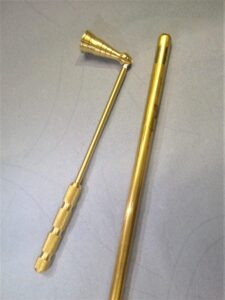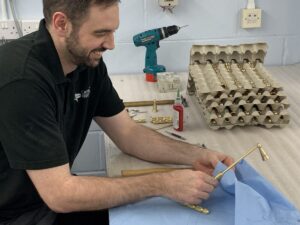It was a cold and snowy night when a dutiful,
young man was called into the office of his revered employer,
Mr Hobbs and set the task of creating 30 brass candle snuffers before the dawn of Christmas Day.
No … the story isn’t really set in a Dickensian winter, it is actually set in Cambridge, the UK’s technology centre, where skilled engineer Gary Cole, works for innovation leader, Cambridge Precision Ltd.
Cambridge Precision prides itself on the skill and ingenuity of the staff and a company-wide commitment to supporting 21st century invention. The setting is contemporary, but the premise of this story is indeed true. Gary was asked by Richard to design and create 30 brass candle snuffers, combining the best of manufacturing technology with his own creative flare and metalwork craftsmanship.
The candle-snuffers were presented to thirty VIPs at the House of Lords, at a dinner meeting to celebrate the work of the Heritage Crafts Association, which Gary also attended. The HCA is the advocacy body for traditional heritage crafts. Working in partnership with Government and key agencies, it provides a focus for craftspeople, groups, societies and guilds, as well as individuals who care about the loss of traditional craft skills, and works towards a healthy and sustainable framework for the future.
The project
“To be honest, I didn’t actually know what a candle-snuffer was.” explains Gary, who has built his career f rom apprentice to Lead Programmer/Engineer in the Turn Mill team. “I researched photos and drawings and then set about the challenge of designing an aesthetic and functional product”. The brass artefact that Gary created is manufactured from three individual components, each manufactured on a four axis turn mill machine. This hi-tech machine enables multiple parts to be worked on simultaneously, each being machined to create a different finish. The handle of the candle snuffer for example, was created by a diamond knurl, where two free spinning wheels, oppose to cut into the metal, creating the cosmetically appealing and practical finish required.
rom apprentice to Lead Programmer/Engineer in the Turn Mill team. “I researched photos and drawings and then set about the challenge of designing an aesthetic and functional product”. The brass artefact that Gary created is manufactured from three individual components, each manufactured on a four axis turn mill machine. This hi-tech machine enables multiple parts to be worked on simultaneously, each being machined to create a different finish. The handle of the candle snuffer for example, was created by a diamond knurl, where two free spinning wheels, oppose to cut into the metal, creating the cosmetically appealing and practical finish required.
The snuffer itself was formed from a solid piece of brass, with dual action tooling employed to shape the outside into a conical tower and at the same time bore out the internal cavity – the result being the head of the snuffer. The extremities of the piece were all softened by adding a radius to remove the sharp metal edges.
These pieces were combined with a cylindrical shaft and manually assembled by tapping in a dowel pin as a pivot for the snuffer, allowing it to move smoothly.
“I loved this job. Making something complete and purposeful and using my own ideas to manufacture and style it has been really satisfying. From concept through to final assembly I have tooled and finished each one, and I hope that they will be valued as a limited edition, which illustrates the combination of modern-day digital manufacturing techniques and good old-fashioned manual craftsmanship.”






